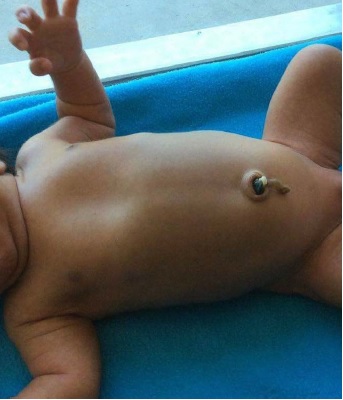Bronze baby syndrome, an unpredictable complication of phototherapy: A case report
Abstract
The bronze baby syndrome is an infrequent dyschromia resulting from phototherapy in newborn babies with neonatal jaundice. Even though the common phenotype has been described in patients with direct neonatal hyperbilirubinemia secondary to cholestasis, several cases of patients with indirect neonatal hyperbilirubinemia who have managed to reverse it have been reported, as well as patients with isolated hyperbilirubinemia.
Currently, the physiopathology of this condition is still a subject of controversy and, therefore, there is a lack of clear conducts for its correct diagnosis and treatment.
Generally, this syndrome has been considered as a mild condition that is resolved with the suspension of phototherapy. Its duration is usually not greater than the neonatal period, and it has no long-term sequelae. However, its occurrence is considered an absolute contraindication for the continuation of phototherapy. In case of persistence, the recommendation is to decrease bilirrubin levels and proceed with exchange transfusion; this procedure, however, represents risks for the newborn, so our recommendation is to suspend phototherapy and reinitiate it if the direct bilirrubin value decreases, and
cholestasis compromise has been discarded. Serial evaluations of acute encephalopathy caused by bilirrubin are absolutely recommended.
The objective of this paper was to describe the case of a newborn with ABO incompatibility who developed the bronze baby syndrome. This patient responded satisfactorily to the suspension and resumption of phototherapy without exchange transfusion.
Downloads
References
Ottinger D. Bronze baby syndrome. Neonatal Netw. 2013;32:200-2. https://doi.org/10.1891/0730-0832.32.3.200
Kopelman AE, Brown RS, Odell GB. The “bronze” baby syndrome. A complication of phototherapy. J Pediatr. 1972;81:466-72. https://doi.org/10.1016/s0022-3476(72)80172-0
Ngoc Le T, Reese J. Bronze baby syndrome. J Pediatr. 2017;188:301. https://doi.org/10.1016/j.jpeds.2017.05.005
Rubaltelli FF, Jori G, Reddi E. Bronze baby syndrome: A new porphyrin-related disorder. Pediatr Res. 1983;17:327–30. https://doi.org/10.1203/00006450-198305000-00004
McDonagh AF. Bilirubin, copper-porphyrins, and the bronzebaby syndrome. J Pediatr. 2011;158:160-4. https://doi.org/10.1016/j.jpeds.2010.08.014
Ramachandran A. Neonatal hyperbilirubinaemia. Paediatr Child Health. 2016;26:162-8. https://doi.org/10.1016/j.paed.2015.12.002
American Academy of Pediatrics Steering Committee on Quality Improvement and Management. Management of hyperbilirubinemia in the newborn infant 35 or more weeks of gestation. Pediatrics. 2004;114:297-316. https://doi.org/10.1542/peds.114.1.297
Some similar items:
- Roxana De las Salas, Daniela Díaz-Agudelo, Adverse drug reactions in neonates hospitalized in neonatal intensive care units in Barranquilla, Colombia , Biomedica: Vol. 37 No. Sup.1 (2017): Suplemento 1, Alteraciones del sistema nervioso
- Juan Gabriel Piñeros, Margarita Arboleda, Juan Camilo Jaramillo, Silvia Blair, Report of five cases of severe neonatal Plasmodium vivax malaria in Urabá, Colombia , Biomedica: Vol. 28 No. 4 (2008)
- Islendy Noreña, Myriam Patricia Pardo, Ismena Mockus, Serum adipokine levels and insulin resistance in the first trimester of pregnancy in adolescents and their relationship with neonatal weight , Biomedica: Vol. 38 No. 3 (2018)
- Eliana Patricia Calvo, Carolina Coronel-Ruiz, Syrley Velazco, Myriam Velandia-Romero, Jaime E. Castellanos, Dengue and Chikungunya differential diagnosis in pediatric patients , Biomedica: Vol. 36 (2016): Suplemento 2, Enfermedades virales
- Husein Husein-El Ahmed, Guillermo Arturo Cañadas-De la Fuente, Rafael Fernández-Castillo, Emilio González-Jiménez, Jesús Cantero-Hinojosa, Marita Lardón-Fernández, Generalized cutaneous candidiasis in newborn at term , Biomedica: Vol. 32 No. 2 (2012)
- Doris Martha Salgado, Jairo Antonio Rodríguez, Liliana del Pilar Lozano, Tatiana Esther Zabaleta, Perinatal dengue , Biomedica: Vol. 33 (2013): Suplemento 1, Fiebres hemorrágicas
- Claudia Marcela Muñoz, José Orlando Castillo, Daniela Salas, Milena Alexandra Valderrama, Claudia Teresa Rangel, Heiddy Patricia Vargas, Diana Carolina Silva, Atypical mucocutaneous manifestations in neonates and infants with chikungunya fever in the municipalities of Cúcuta, Los Patios and Villa del Rosario, Norte de Santander, Colombia, 2014 , Biomedica: Vol. 36 No. 3 (2016)
- Luis Alfonso Pérez, Diana Marcela González, Karen Margarita de Jesús Álvarez, Luis Alfonso Díaz-Martínez, Nasal CPAP versus mechanical ventilation in 28 to 32-week preterm infants with early surfactant administration , Biomedica: Vol. 34 No. 4 (2014)
- Yolanda Cifuentes, Martha Isabel Murcia, Jorge Piar, Patricia Pardo, Cerebral microcalcifications in a newborn with congenital tuberculosis , Biomedica: Vol. 36 No. 1 (2016)
- Yolanda Cifuentes, Isabel De la Hoz, Martha Bermúdez, Clara Arteaga, Neonatal onset of organic acidemia (propionic) diagnosed by tandem mass spectrometry , Biomedica: Vol. 28 No. 1 (2008)

| Article metrics | |
|---|---|
| Abstract views | |
| Galley vies | |
| PDF Views | |
| HTML views | |
| Other views | |

























